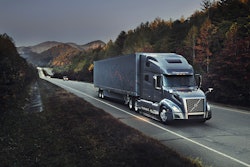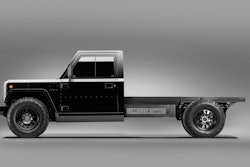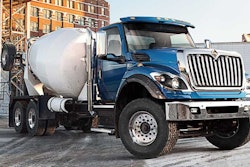Editor’s note: This is the first of a two-part series on carriers’ changing mobile technology needs. Part 2 will publish Wednesday, May 13, and showcase more technologies and mobile strategies fleets are using to reduce costs and improve the driver experience.
Before COVID-19, many motor carriers were re-evaluating their mobile strategies thoroughly to ensure compliance with new rules such as the Food Safety Modernization Act (FSMA) and the electronic logging device (ELD) mandate.
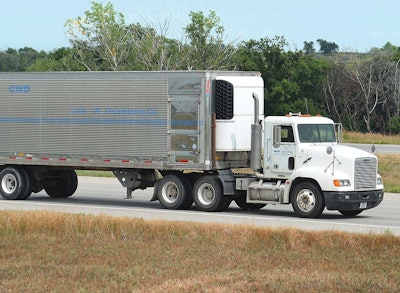 Cash-Wa Distributing is able to manage its tractor and trailer assets with a single cellular connection via the Samsara mobile platform.
Cash-Wa Distributing is able to manage its tractor and trailer assets with a single cellular connection via the Samsara mobile platform.Another driving force was the need to convert older hardware from 3G cellular technology to devices that connect to later-generation 4G and 5G networks.
More recently, economic disruptions from the coronavirus pandemic and, as a result, worker safety have given carriers new reasons to help revisit their mobile technologies to reduce costs and streamline workflow for drivers and fleet administrators.
Tasks that traditionally have been done in person, such as driver coaching and training, are being pushed to mobile technologies to help enforce social distancing protocols.
Consolidating technology
Cash-Wa Distributing, an independent broadline food distributor, evaluated its mobile technology in 2016 for FSMA compliance. The Kearney, Nebraska-based company set up an internal committee to identify any needs.
The company’s warehouse monitored temperatures of products stored in its coolers and freezers, but its fleet lacked a trailer monitoring system to record ambient temperatures and door open/closed events from pickup through delivery.
To close this coverage gap, Cash-Wa needed a system to monitor and record trailer temperatures for documenting food safety and preventing cargo claims. With trailer monitoring technology, the company could prove to customers that their products, such as fresh lettuce, were being maintained at a constant temperature throughout its supply chain, said Jim Hoss, vice president of operations and transportation for Cash-Wa.
However, all the trailer monitoring products Hoss evaluated would add another cellular data plan to its vehicles and leave office personnel with another web portal to oversee, and both results were less than ideal. Management wanted to use the cellular connection of a single vehicle gateway that connected to other mobile devices through a WiFi hotspot.
As it stood, Cash-Wa would need at least four cellular connections to each vehicle to support its wish list of Internet of Things (IoT) systems that also included a driver handheld application, an ELD, cameras and trailer and tire pressure monitoring systems, Hoss said.
The company ultimately found a platform from Samsara that made it possible to consolidate all its mobile needs. Cash-Wa deployed Samsara vehicle gateways (VGs), trailer asset gateways (AGs) and 440 wireless environment monitors (EMs) across its fleet of 175 tractors and 220 trailers.
For a driver display, the company began using Zebra TC75 ruggedized Android handhelds with scanners. The handhelds connect with Samsara’s gateways through a built-in WiFi hotspot to update information as drivers scan product into trailers at pickups and out of them at deliveries.
Cash-Wa’s custom-built driver handheld application and its back-office software system integrates with the application programming interfaces (APIs) of the Samsara platform to obtain the GPS, temperatures and driver log data the company needs for customer service, billing and payroll.
“The open API gives us the freedom to utilize the sensor data for our own purposes,” Hoss said.
Using the handheld application, Cash-Wa captures a digital signature from customers during delivery to expedite invoicing. However, many customers still use paper delivery documents.
“We would love to get away from paper,” Hoss said. The COVID-19 crisis “is as good of an opportunity as any to make that push to getting a digital signature,” he said.
From the Samsara web portal, Hoss can view the GPS location of all the fleet’s tractors and trailers, along with the temperature graphs for both the frozen and refrigerated compartments of each trailer.
With end-to-end visibility of temperature data, Cash-Wa has decreased the credits paid out to customers due to improper temperature claims by 30%, Hoss estimates.
Cash-Wa also manages its ELD, electronic vehicle inspection reporting and messaging applications from the same portal. It recently began using Samsara’s camera system to record critical safety events.
“Literally, when I arrive in the morning, Samsara is the first screen I look at,” he said.
Hoss said that Cash-Wa’s business volumes — in terms of delivery stops and piece counts — are down about 25% during COVID-19. Many businesses in the food distribution industry have seen their fleets’ stop counts decline by 50% or more, he said.
To help keep the business’ costs in line with revenues, Hoss looks at miles and hours every day to eliminate routes where needed. Compared to pre-pandemic levels, the fleet’s total miles are down 22%, and total hours are down 26%.
Improving driver workflow
During COVID-19, fleets also have been implementing new mobile strategies to limit the need for drivers to come to the office or terminal. Fleets that hire drivers with limited industry experience are using video-based safety systems to onboard them.
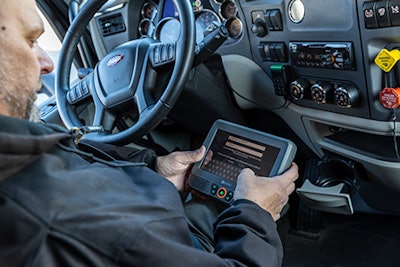 With the SmartDrive system, fleets can send drivers messages through an in-cab telematics platform to alert them to safety risks.
With the SmartDrive system, fleets can send drivers messages through an in-cab telematics platform to alert them to safety risks.SmartDrive, which provides a video-based driver safety and risk management platform, has been working with fleet customers to help provide them with extra focus and support for driver training, said Jason Palmer, chief operating officer.
“We have had these discussions before from a cost-saving perspective, but this added health concern has really accelerated implementations of ways to affect distance learning and oversight,” Palmer said.
SmartDrive can integrate with various telematics systems and mobile technologies to provide “a lot of situational awareness” to drivers, he said. Integrations with telematics systems have become more common for fleets to set up automated “messaging tables” from SmartDrive. The messages can alert drivers to risky behaviors such as distraction and fatigue through alerts and messages sent through an in-cab telematics system.
Drivers also can receive scores for their safety-related behaviors, and Palmer sees more fleets consolidating driver information from various mobile systems into driver-facing scorecards and custom workflows.
Eleos Technologies can bring together data from a fleet’s ELDs, fuel cards and video-based safety system into a centralized driver dashboard, Palmer said.
SmartDrive’s driver app, which has fuel and safety scores, can be added to a custom Eleos dashboard. The company’s professional services team supports customers with these and other needs for system integrations, he said.
A trend that started before COVID-19 that now has picked up momentum is for fleets to use mobile strategies to eliminate duplicate cellular connections and consolidate functions to give drivers and office personnel a more streamlined user experience.



